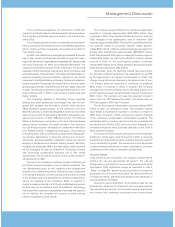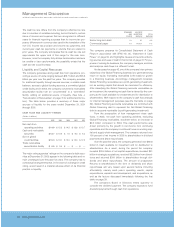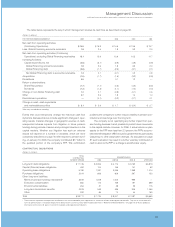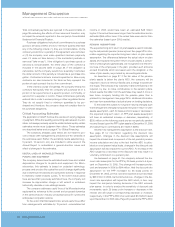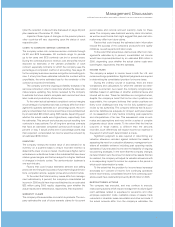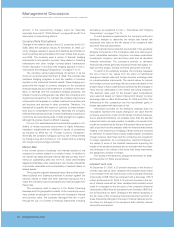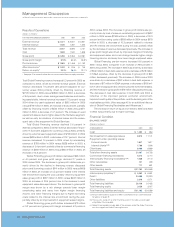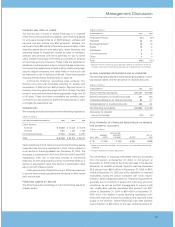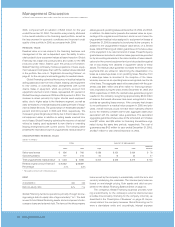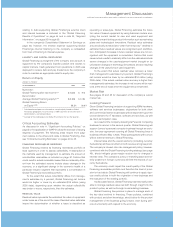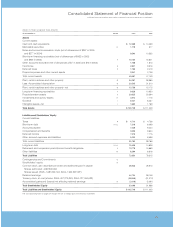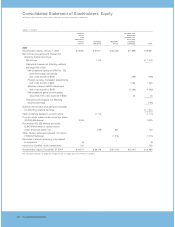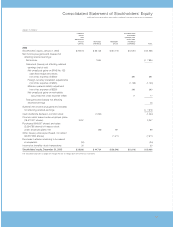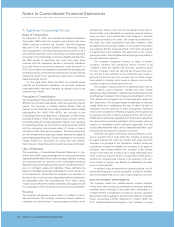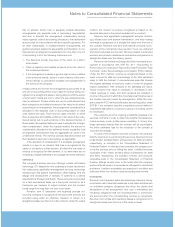IBM 2005 Annual Report Download - page 48
Download and view the complete annual report
Please find page 48 of the 2005 IBM annual report below. You can navigate through the pages in the report by either clicking on the pages listed below, or by using the keyword search tool below to find specific information within the annual report.
ManagementDiscussion
INTERNATIONALBUSINESSMACHINESCORPORATION ANDSUBSIDIARYCOMPANIES
_47
relating to debt supporting Global Financing’s external client
and internal business is included in the “Global Financing
Results of Operations” on page 44 and in note W, “Segment
Information,” onpages 95 through 99.
In the company’s Consolidated Statement of Earnings on
page 48, however, the interest expense supporting Global
Financing’s internal financing to the company is reclassified
fromCostoffinancingtoInterestexpense.
LIQUIDITY AND CAPITAL RESOURCES
GlobalFinancingisasegmentofthecompanyandassuch,is
supported by the company’s liquidity position and access to
capitalmarkets. Cash generatedfromoperations in 2005 was
deployedtoreducedebtandpaydividendstothecompanyin
ordertomaintainanappropriatedebt-to-equityratio.
ReturnonEquity
(Dollarsinmillions)
ATDECEMBER31: 2005 2004
Numerator:
GlobalFinancingaftertaxincome(a)*$«1,032 $««««915
Denominator:
AverageGlobalFinancingequity(b)** $«3,109 $«3,194
GlobalFinancingReturn
onEquity(a)/(b) 33.2% 28.6%
* CalculatedbaseduponanestimatedtaxrateprincipallybasedonGlobal
Financing’sgeographicmixofearningsasIBM’sprovisionforincometaxesis
determinedonaconsolidatedbasis.
** AverageoftheendingequityforGlobalFinancingforthelastfivequarters.
CriticalAccountingEstimates
As discussed in note A, “Significant Accounting Policies,” on
page 54,theapplicationofGAAPinvolvestheexerciseofvarying
degrees of judgment. The following areas require more judg-
mentrelativetotheothersandrelatetoGlobalFinancing.Also
see“CriticalAccountingEstimates” onpages40to42.
FINANCING RECEIVABLES RESERVES
Global Financing reviews its financing receivables portfolio at
leastquarterlyinorderto assess collectibility.Adescriptionof
the methods used by management to estimate the amount of
uncollectible receivables is included on page 61. Factors that
couldresultinactualreceivablelossesthataremateriallydiffer-
ent from the estimated reserve include sharp changes in the
economy, or a significant change in the economic health of a
particular industry segment that represents a concentration in
GlobalFinancing’sreceivablesportfolio.
Totheextentthatactualcollectibilitydiffersfrommanage-
ment’s estimates by 5 percent, Global Financing net income
would be higher or lower by an estimated $16 million (using
2005 data), depending upon whether the actual collectibility
wasbetterorworse,respectively,thantheestimates.
RESIDUAL VALUE
Residualvaluerepresentstheestimatedfairvalueofequipment
underleaseasoftheendofthelease.Residualvalueestimates
impact the determination of whether a lease is classified as
operating or sales-type. Global Financing estimates the future
fairvalueofleasedequipmentbyusinghistoricalmodels,ana-
lyzing the current market for new and used equipment and
obtainingforward-lookingproductinformationsuchasmarketing
plans and technological innovations. Residual value estimates
areperiodicallyreviewedand “otherthantemporary” declinesin
estimatedfutureresidualvaluesarerecognizeduponidentifica-
tion.Anticipatedincreasesinfutureresidualvalues arenotrec-
ognized until the equipment is remarketed. Factors that could
causeactualresultstomateriallydifferfromtheestimatesinclude
severe changes in the used-equipment market brought on by
unforeseenchangesintechnologyinnovationsandanyresulting
changesintheusefullivesofusedequipment.
To the extent that actual residual value recovery is lower
thanmanagement’sestimatesby5percent,GlobalFinancing’s
netincomewould be lower by anestimated$16 million(using
2005data).Iftheactualresidualvaluerecoveryishigherthan
management’sestimates,theincreaseinnetincomewillbereal-
izedattheendofleasewhentheequipmentisremarketed.
MarketRisk
See pages 42 and 43 for discussion of the company’s overall
marketrisk.
LookingForward
GivenGlobalFinancing’smissionofsupportingIBM’shardware,
software and services businesses, originations for both client
andcommercialfinancebusinesseswillbedependentuponthe
overalldemandforIThardware,softwareandservices,aswell
as client participationrates.
AsaresultofthecompanydivestingitsPersonalComputing
businesstoLenovointhesecondquarter,GlobalFinancingwill
supportLenovo’s personalcomputer businessthroughanexclu-
sive, five-yearagreementcoveringallGlobal Financing linesof
businesseffectiveMay1,2005.TheseparticipationswithLenovo
willbeexternalrevenuetoGlobalFinancing.
Interestratesandtheoveralleconomy(includingcurrency
fluctuations)willhaveaneffectonbothrevenueandgrossprofit.
Thecompany’s interestrateriskmanagement policy, however,
combinedwiththeGlobalFinancingfundingstrategy(seepage
46), should mitigate gross margin erosion due to changes in
interestrates.Thecompany’spolicyofmatchingassetandlia-
bilitypositionsinforeigncurrencieswilllimittheimpactsofcur-
rencyfluctuations.
TheeconomycouldimpactthecreditqualityoftheGlobal
Financingreceivablesportfolioandthereforethelevelofprovi-
sionforbaddebts.GlobalFinancingwillcontinuetoapplyrigor-
ouscreditpoliciesinboththeoriginationofnewbusinessand
theevaluationoftheexistingportfolio.
Asdiscussedabove,GlobalFinancinghashistoricallybeen
abletomanageresidualvalueriskboththroughinsightintothe
productcycles,aswellasthroughitsremarketingbusiness.
GlobalFinancing haspoliciesinplacetomanage eachof
the key risks involved in financing. These policies, combined
withproductand client knowledge,shouldallowfortheprudent
managementofthebusinessgoing forward,evenduringperi-
odsofuncertaintywithrespecttotheeconomy.


